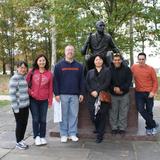- New River Community College is a two-year institution of higher learning operating under a state-wide system of community colleges. The college serves those who live in the counties of Floyd, Giles, Pulaski, Montgomery, and the city of Radford.
School Highlights
New River Community College serves 5,699 students (27% of students are full-time).
The college's student-teacher ratio of 32:1 is higher than the state community college average of 23:1.
Minority enrollment is 22% of the student body (majority Hispanic and Black), which is less than the state average of 53%.
Quick Facts (2025-26)
- Enrollment: 5,699 students
- In-state tuition: $3,325
- Out-state tuition: $7,995
- Student-teacher ratio: 32:1
- Minority enrollment: 22%
- Source: Integrated Postsecondary Education Data System (IPEDS)
Top Rankings
New River Community College ranks among the top 20% of public schools in Virginia for:
Category
Attribute
Affordability
School Overview
The teacher population of 180 teachers has stayed relatively flat over five years.
New River Community College
(VA) Community College Avg.
Carnegie Classification
Associate's Colleges: Mixed Transfer/Career & Technical-High Nontraditional
Associate's Colleges: Mixed Transfer/Career & Technical-Mixed Traditional/Nontraditional
Institution Level
At least 2 but less than 4 years
At least 2 but less than 4 years
Institution Control
Public
Public
Total Faculty
180 staff
129 staff
School Calendar
Student Body
The student population of New River Community College has grown by 31% over five years.
The student-teacher ratio of 32:1 has increased from 23:1 over five years.
The New River Community College diversity score of 0.38 is less than the state average of 0.71. The school's diversity has grown by 12% over five years.
Total Enrollment
5,699 students
1,608 students
Student-Teacher Ratio
32:1
23:1
# Full-Time Students
1,539 students
637 students
# Part-Time Students
4,160 students
971 students
# Enrollment Undergraduate
569 students
314 students
# Full-Time Undergraduate Students
1,539 students
611 students
# Full-Time Graduate Students
n/a
158 students
# Part-Time Undergraduate Students
4,160 students
971 students
# Part-Time Graduate Students
n/a
61 students
Total Dormitory Capacity
n/a
476 students
% American Indian/Alaskan
n/a
n/a
% Asian
3%
8%
% Hispanic
5%
13%
% Black
4%
21%
% White
78%
47%
% Hawaiian
n/a
n/a
% Two or more races
4%
5%
% Non Resident races
2%
2%
% Unknown races
3%
4%
Diversity Score
0.38
0.71
College Completion Rate (Students who graduate in less than 4 years)
47%
41%
College Completion Rate (Students who graduate in 4 years or more than 4 years)
n/a
26%
Average Graduate Earnings (10 Years)
$33,200
$29,600
Tuition and Acceptance Rate
The public in-state tuition of $3,325 is less than the state average of $3,748. The in-state tuition has declined by 29% over four years.
The public out-state tuition of $7,995 is less than the state average of $8,977. The out-state tuition has declined by 25% over four years.
In-State Tuition Fees
$3,325
$3,748
Out-State Tuition Fees
$7,995
$8,977
% Students Receiving Some Financial Aid
55%
77%
Median Debt for Graduates
$9,750
$10,500
Median Debt for Dropouts
$5,250
$5,500
Acceptance Rate
n/a
59%
Source: 2024 (or latest year available) Integrated Postsecondary Education Data System (IPEDS) , School Administrators
School Notes
- In 1959 New River Community College began offering vocational/technical courses as a vocational/technical school to residents in the New River Valley. It is one of five colleges which developed from existing vocational/ technical schools into community colleges under 1966 General Assembly legislation which formed the Virginia Community College System. The college continued the occupational/technical programs in Machine Shop, Drafting and Design, Auto Mechanics, Practical Nursing, Industrial Electricity, Electronics, Instrumentation, Clerk Typing, and Stenography.Programs leading to the Associate in Applied Science Degree in Accounting, Business Management and Secretarial Science were added in the fall term of 1970. Degree programs designed for transfer to four-year colleges were also offered at that time. These included the Associate of Arts Degree program in Liberal Arts and the Associate in Science Degree programs in Science, Education, Business Administration, and General Studies. The college is located on a one-hundred acre site at the intersection of U.S. Routes 11 and 100 in Dublin, Virginia. The campus provides modern, well-equipped facilities for the vocational/technical programs as well as for university- parallel programs. The facilities contain labs for Administrative Support Technology, Accounting, Automotive, Drafting and Design, Electronics, Electricity, Fiber Optics, Forensic Science, Information Systems Technology, Instrumentation, Machine Shop, Natural Science classes, Network Design and Installation, Nursing, Programmable Logic Controllers, and Welding. New River Community College offers programs two years beyond the high school level. The college offers Occupational/Technical Education, University parallel/College transfer Education, General education, Continuing education, Customized training programs, Developmental courses NRCC is accredited by the Commission on Colleges of the Southern Association of Colleges and Schools to award the associate degree.
Frequently Asked Questions
How much does New River Community College cost?
New River Community College's tuition is approximately $3,325 for In-State students and $7,995 for Out-State students.
What is New River Community College's ranking?
New River Community College ranks among the top 20% of community college in Virginia for: Least expensive tuition.
Recent Articles

The Rise of Technical and Vocational Training in 2025
Explore the 2025 surge in technical and vocational training—enrollment, policy, costs, and why this path is gaining ground for students and parents.

Stackable Credentials: How Community Colleges Advance Careers
Discover how community colleges use stackable credentials to build career pathways, boost earnings, and enable lifelong learning in 2025.

High-Paying Jobs You Can Get with a Community College Degree
Discover top high-paying careers you can launch in 2025 with a community college (associate) degree and high-growth credentials in tech, healthcare and trades.










